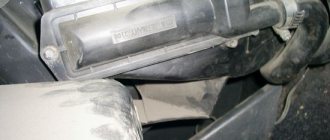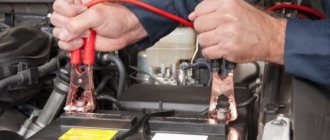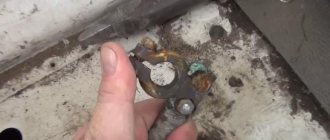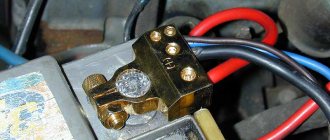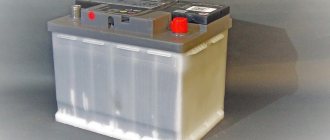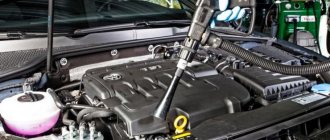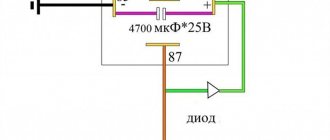The battery is one of the important elements of the machine. Without it, it is almost impossible to start the engine. Plus, it powers all energy consumers when the engine is not running and takes over the responsibilities of the generator.
Battery failure is a common and annoying problem. Practice shows that the contacts on the battery may become loose or the terminal may be damaged.
The first problem is not difficult to solve. Usually just tightening the fasteners is enough. With a broken terminal, everything is more complicated. Here it is already necessary to replace it. The procedure is not complicated, and therefore many people take it on themselves.
Why do terminals loosen and break?
The terminals on a car battery cannot be simply replaced. This element must be damaged, worn out or deformed.
This happens mainly due to the fault of the car owner himself. The following reasons are identified:
- Removing the battery and resetting the terminals. These elements are made from soft metals. It's mostly lead. But aluminum, copper and brass are also used. If you frequently remove the battery by unscrewing the fasteners, the components will wear out. At some point, the clamp loses its strength, and the terminal may even become deformed or break;
- Strong puff. Drivers make sure that contact is not lost. And then they use all their strength to tighten it. In practice this is not necessary. Excessive force will only damage the terminals. They break off and crack;
- Overheat. If there are problems with the contacts or wiring, the terminals may overheat. Poor contact and other problems lead to an increase in the temperature of the metal terminals on the battery. As a result, they become deformed.
Trying to repair the terminals on a battery is dangerous. It is better to immediately replace them with new and high-quality ones.
Causes of terminal wear
Battery terminals can wear out for many reasons. Most often, craftsmen are forced to change such elements due to:
- Poor quality metal.
- Insufficient contact.
- Incorrect installation.
- Severe oxidation.
- Reflow.
- Mechanical destruction.
If the connecting element is made of low-quality material, it may burst or collapse within a short time due to corrosion.
Insufficient contact between the battery terminals and the connected elements may be due to this very reason. The terminals can be reversed, which will also cause insufficient contact between the connected elements.
In the latter case, you can break the product when connecting a product of a smaller diameter to the positive terminal, and when connecting an element that is too large to the negative terminal, a large gap will be observed.
The oxidation of the material will also occur more intensely if there is not good enough contact between the surfaces being joined.
Possible consequences
Not all drivers understand what damage to the terminals or loosening of their fixation can lead to.
In this scenario, the efficiency of the vehicle's entire electrical system is reduced. Some nodes may even stop working altogether.
There are several common consequences.
- Rapid battery discharge. Even if the parking was short, during this period the battery could lose all capacity. It is now impossible to start the engine;
- The starter is not working well. You may try to start the engine several times without success. But broken contact will not allow this;
- Contacts are oxidized. A white coating appears on the terminals and electrodes. This is the result of oxidative processes. As a result, the battery may not charge properly while driving, and may also quickly discharge when stopped;
- Load on high-voltage wires. It is increasing. The result may be burnt wires and fires;
- Damage to electrical equipment. Systems operating from the on-board network may fail. Many components do not like voltage surges. Devices glitch, settings get lost, or simply stop working.
Timely maintenance and monitoring of the condition of the battery will help to avoid such consequences. If you notice that the terminals no longer hold or transmit charge correctly, they should be replaced.
Replacing the positive battery terminal
If there is a need to replace the positive terminal, select the desired terminal from the pair. The sequence for removing and installing the component is the same for both electrodes.
- Remove the contacts from the wire, then release the anode from the clamp placed on top.
- Clean the contact and prepare the wires for installation.
- First of all, connect the high-voltage cables from the on-board network and additional wires from the music center.
- Place the contact on the anode pin and secure it to it.
You might also find a practical guide on how to properly tighten terminals, video, useful
Replacing battery terminals
How to choose terminals
The market offers a large number of different terminals for batteries. Before replacing, you need to choose the appropriate option.
Differences between types of car battery terminals
The element must correspond to the dimensional characteristics of the standard terminals on the battery, otherwise they will not be installed.
Do not forget about the importance of matching the diameter of the fixing hole for connecting high-voltage wires. They should hold tight and securely.
As for materials, it is recommended to give preference to lead. The material is characterized by high conductivity. At the same time, it is soft and will not create a galvanic couple with the electrode. That is, a terminal or pin on the battery case. An alternative to lead is elements made of copper or lead.
If your car has a powerful audio system with acoustics, then you should take terminals that have additional places for fixing wires.
Kits or kits are also available for sale. This is the terminal into which the wire is pressed. It is considered a good solution, but its installation requires more dexterity and skills.
If the car did not have a casing protecting the positive terminal, then it is better to purchase and install it separately. This will prevent the negative effects of moisture, dust, and will also prevent an accidental short circuit to ground.
It is optimal to use quick-release terminals. They will eliminate the need to use keys and other tools, because in some cases the car has to be de-energized as quickly as possible.
In what order should you disconnect the wires when removing the battery?
Repairing the terminals requires dismantling the battery. First of all, the negative terminal is loosened and reset - this order allows you to protect the on-board network from accidental short circuits that are possible when first dismantling the positive contact.
Repairing the terminals with a battery in the engine compartment is not the best idea. There is simply no room for this, and the risk of damaging nearby equipment is high. So we take out the battery and put it aside.
The negative wire can also be removed; it is bolted to the body of the engine compartment. This will not work with a positive cable, so you will have to disconnect the terminal on site. The method of attaching to the cable varies. If it is a bolt terminal, the task is simplified, otherwise, most likely, the wire will have to be cut. If the length of the remaining part is not enough, you can use a special terminal with a built-in voltage sensor, which is longer than the usual one by the required 5–8 centimeters. As a last resort, you can extend the cable with a wire of the same cross-section.
Before starting repairs, make sure that the wire insulation is intact, clean the surface of the terminal terminals from oxides and dirt using coarse sandpaper, a wire brush or a file.
Which one to shoot first?
Before starting work, you need to turn off the power to the machine. To do this, turn off the ignition and disconnect the battery.
Experienced drivers can confidently say which terminal needs to be removed first. But for some reason, even they do not always follow this rule.
And failure to follow the order poses a potential threat. If you accidentally short it to ground, then all the electronics will burn out and the electrics will be damaged. The car could even catch fire. Therefore, you need to remember this once, and for the rest of your life.
The negative terminal is always removed first. After it, you can disconnect the positive one.
If everything is clear with this, then you can get to work.
What could this lead to?
Worn battery terminals can cause a car fire. Internal combustion engines run on fuel that can ignite even from a small electronic discharge.
Worn parts can spark strongly, so a small amount of spilled fuel, oil or gas leak (in machines with gas-cylinder equipment) will be enough for a fire to occur.
Less dangerous, but requiring more time to troubleshoot, can also be caused by the failure of metal connecting parts.
For example, if there is insufficient contact between the terminals and the battery terminals, and with a significant electrical load (powerful audio amplifiers, air conditioning, etc.), the generator will operate in extreme mode. An increased load on this part will lead to its failure.
The inability to start the engine at any time of the year is also one of the “symptoms” of worn-out connected elements. At the same time, car owners often blame the battery for such a malfunction and even make attempts to replace the power source.
Failure to start the engine when necessary can not only result in being late for work, but can also cause serious accidents.
Battery connection
When installing the battery, you need to check the condition of the wires leading to it, clean the clamps from corrosion and lubricate the clamping screws. To properly connect the battery in a car, you first need to make sure that no one is in the car, since the connection may activate the airbags. All actions must be performed in the reverse order to what was done during removal. The sequence of connecting the battery terminals should be as follows:
- The first thing you need to do is put the red wire on the plus terminal of the battery.
- Connect the negative black wire next.
- Tighten the nuts with a 10 mm wrench.
- Secure the battery, put on the pressure plate, tighten the bolts.
When you first turn on the ignition after installing the battery, you must be outside the car. After installing the battery, you should check the operation of the lighting devices. To do this, it is necessary, without starting the engine, to check that the low and high beam headlights are on, the operation of the windshield wipers, and the hazard warning lights. If you connect the battery correctly, then everything in the car should work properly. To configure the on-board computer after connecting the power, you need to take the following steps:
- Warm up the engine at idle speed.
- Increase the speed to 2-2.5 thousand and hold for two to three minutes.
- Take a test ride, using sharp acceleration, driving at low and high speeds.
The test ride must be at least 10 kilometers.
To properly connect the battery to a VOLVO car, you need to follow some rules:
- The ignition must be turned off at least 5 minutes before disconnecting the battery, so as not to lose information from the control modules.
- You need to connect the battery in the second position of the ignition key, because this will avoid errors when turning on the modules.
If the car has a remote start system, then when the power is turned off, the access password will be reset to factory settings
Battery care
Proper care and operation will extend the life of the battery. To maintain the battery, you need to wipe its case with a dry, clean cloth to remove moisture and remove dirt and dust from the ventilation holes. If the battery is serviceable, then regularly measure the electrolyte level and its density. Monitor the condition of the contacts, clean the terminals and treat them with a special anti-corrosion compound.
The installation sequence is very important when installing a battery. The main thing is to remember that you must connect the plus first, and then the minus. If everything is done correctly and the on-board computer is configured, then you can count on trouble-free operation of the car.



